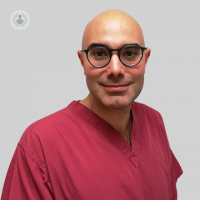Demystifying umbilical hernias
Escrito por:An umbilical hernia occurs when a portion of the intestine protrudes through a weakened abdominal wall near the navel, creating a bulge or noticeable lump. While often benign and more common in infants, adults can also be susceptible to this condition. In his latest online article, Mr Naim Fakih Gomez delves into the depths of understanding umbilical hernias and sheds light on their management and significance.

The anatomy of an umbilical hernia:
At the core of this condition lies a weakened spot in the abdominal wall, often a result of an incomplete closure of the abdominal muscles during foetal development. This weakened area allows a portion of the intestine or abdominal tissue to push through, creating a noticeable bulge around the navel.
While infants are more prone to umbilical hernias due to the incomplete closure of the abdominal muscles at birth, adults can also develop them later in life. Factors such as obesity, pregnancy, and excessive strain on the abdominal area can contribute to the development of umbilical hernias in adults.
Signs and symptoms:
Identifying an umbilical hernia is relatively straightforward. The most common symptom is a noticeable bulge or lump near the navel. This bulge may become more pronounced when coughing, crying, or straining. In many cases, umbilical hernias are painless, but discomfort or tenderness may be experienced around the bulging area.
Complications and risk factors:
While most umbilical hernias are harmless and do not cause severe complications, there are instances where medical attention becomes imperative. Strangulation or incarceration can occur when the herniated tissue becomes trapped and blood flow is restricted. This condition may cause severe pain, nausea, and require immediate medical intervention. Certain risk factors increase the likelihood of developing an umbilical hernia. Obesity, multiple pregnancies, and abdominal surgeries are factors that can contribute to the weakening of the abdominal wall, making individuals more susceptible to this condition.
Management and treatment:
In the majority of cases, especially in infants, umbilical hernias tend to close on their own as the abdominal muscles strengthen over time. However, if the hernia persists beyond the age of 3 to 4 years or if it develops in adulthood, medical intervention may be necessary. Surgical procedures, such as herniorrhaphy or hernioplasty, are common treatments for umbilical hernias. These procedures involve repairing the weakened abdominal wall and securing the protruding tissue back into place. The decision for surgery is often based on the size of the hernia, the presence of symptoms, and the overall health of the individual.
Mr Naim Fakih Gomez is an esteemed bariatric and Upper GI surgeon. You can schedule an appointment with Mr Gomez on his Top Doctors profile.


